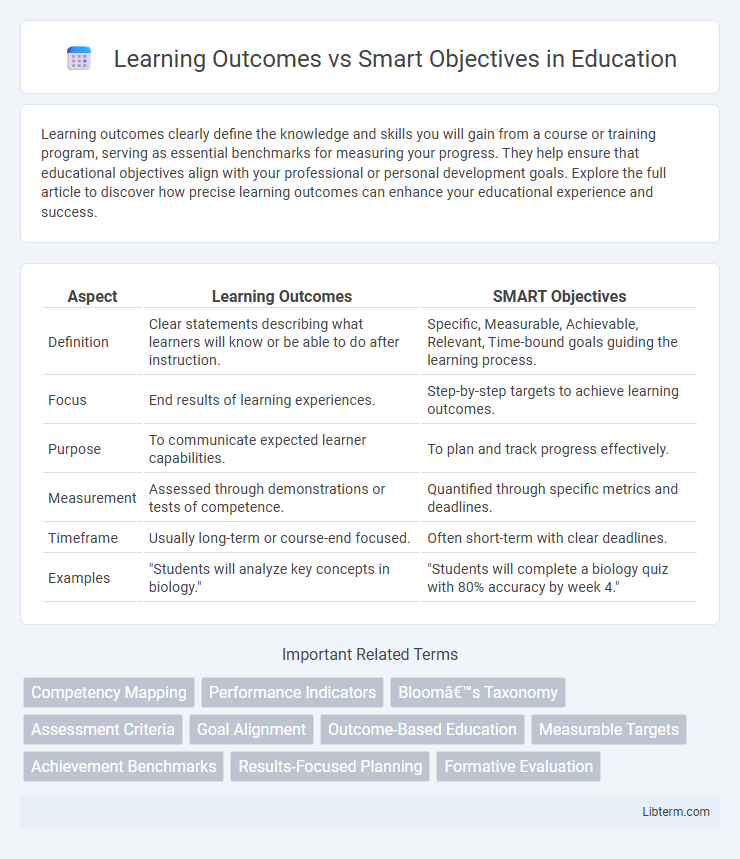Learning outcomes clearly define the knowledge and skills you will gain from a course or training program, serving as essential benchmarks for measuring your progress. They help ensure that educational objectives align with your professional or personal development goals. Explore the full article to discover how precise learning outcomes can enhance your educational experience and success.
Table of Comparison
| Aspect | Learning Outcomes | SMART Objectives |
|---|---|---|
| Definition | Clear statements describing what learners will know or be able to do after instruction. | Specific, Measurable, Achievable, Relevant, Time-bound goals guiding the learning process. |
| Focus | End results of learning experiences. | Step-by-step targets to achieve learning outcomes. |
| Purpose | To communicate expected learner capabilities. | To plan and track progress effectively. |
| Measurement | Assessed through demonstrations or tests of competence. | Quantified through specific metrics and deadlines. |
| Timeframe | Usually long-term or course-end focused. | Often short-term with clear deadlines. |
| Examples | "Students will analyze key concepts in biology." | "Students will complete a biology quiz with 80% accuracy by week 4." |
Understanding Learning Outcomes
Understanding learning outcomes involves clearly defining what knowledge, skills, or attitudes students should acquire after an educational experience. These outcomes focus on measurable and observable student performance, often framed using Bloom's Taxonomy to specify cognitive levels such as remembering, understanding, applying, analyzing, evaluating, and creating. Learning outcomes guide curriculum design and assessment strategies by providing specific targets for student achievement beyond the broader scope of SMART objectives.
Defining SMART Objectives
SMART objectives are specific, measurable, achievable, relevant, and time-bound goals designed to provide clear direction and accountability in project management and personal development. Unlike broad learning outcomes, SMART objectives break down goals into concrete steps that can be quantitatively evaluated and tracked for progress. Defining SMART objectives ensures clarity in expectations and enhances the ability to achieve targeted results within a set timeframe.
Key Differences between Learning Outcomes and SMART Objectives
Learning outcomes define the specific knowledge or skills a learner is expected to acquire, emphasizing measurable changes in behavior or understanding by the end of a course or program. SMART objectives are strategic, focusing on being Specific, Measurable, Achievable, Relevant, and Time-bound to ensure clear and attainable goals in project management or instructional design. The key difference lies in learning outcomes targeting educational achievement, while SMART objectives guide the planning and evaluation process with precise criteria for success.
The Importance of Clarity in Educational Goals
Clear educational goals enhance student understanding and guide instruction effectively by distinguishing between learning outcomes and SMART objectives. Learning outcomes specify what students should know or be able to do after instruction, focusing on measurable and observable skills, while SMART objectives provide a detailed, time-bound roadmap for achieving these outcomes with specific, attainable targets. Clarity in these goals ensures alignment between teaching methods, assessment, and student expectations, facilitating improved academic performance and motivation.
How to Formulate Effective Learning Outcomes
Effective learning outcomes are specific, measurable, achievable, relevant, and time-bound statements that clearly define what learners will know, understand, or be able to do after a course or module. Unlike SMART objectives that focus on the steps required to achieve a goal, well-formulated learning outcomes emphasize learner-centered achievements and observable behavior. To craft precise learning outcomes, use action verbs from Bloom's Taxonomy, align them with assessment methods, and ensure they reflect cognitive, affective, or psychomotor domains.
Crafting SMART Objectives for Success
Crafting SMART objectives involves setting Specific, Measurable, Achievable, Relevant, and Time-bound goals that guide focused learning experiences and assess progress effectively. Unlike broad learning outcomes, SMART objectives offer clear criteria for evaluating success and facilitate targeted instructional planning. Precise SMART objectives enhance motivation and accountability, driving measurable improvements in educational performance.
Aligning Learning Outcomes with SMART Objectives
Aligning learning outcomes with SMART objectives ensures clear, measurable, and achievable goals that enhance educational effectiveness. SMART objectives--Specific, Measurable, Achievable, Relevant, and Time-bound--provide precise criteria that directly correlate with detailed learning outcomes, facilitating targeted assessments. This alignment promotes improved curriculum design and student performance by linking theoretical goals to practical, quantifiable achievements.
Common Challenges in Setting Goals
Learning outcomes and SMART objectives often face common challenges such as lack of clarity, measurability issues, and unrealistic expectations. Many educators struggle to define specific, achievable, and time-bound targets that align with desired learning outcomes. Addressing these challenges requires precise language, measurable indicators, and achievable benchmarks to ensure effective goal-setting in educational contexts.
Measuring Progress: Outcomes vs Objectives
Learning outcomes provide clear criteria for assessing the knowledge and skills acquired by students, enabling educators to measure actual progress and achievement. SMART objectives set specific, measurable, achievable, relevant, and time-bound targets that help track incremental steps toward broader goals. While learning outcomes emphasize end results and competencies gained, SMART objectives focus on the detailed actions and milestones necessary to reach those outcomes.
Best Practices for Educational Planning and Assessment
Learning outcomes define the specific knowledge, skills, and attitudes students are expected to achieve, while SMART objectives provide a framework for creating clear, measurable, achievable, relevant, and time-bound goals in educational planning. Best practices emphasize aligning learning outcomes with SMART objectives to ensure coherent curriculum design, effective teaching strategies, and precise assessment methods. Consistent use of data-driven evaluation helps educators refine objectives and improve student performance tracking, fostering continuous improvement in educational quality.
Learning Outcomes Infographic

 libterm.com
libterm.com